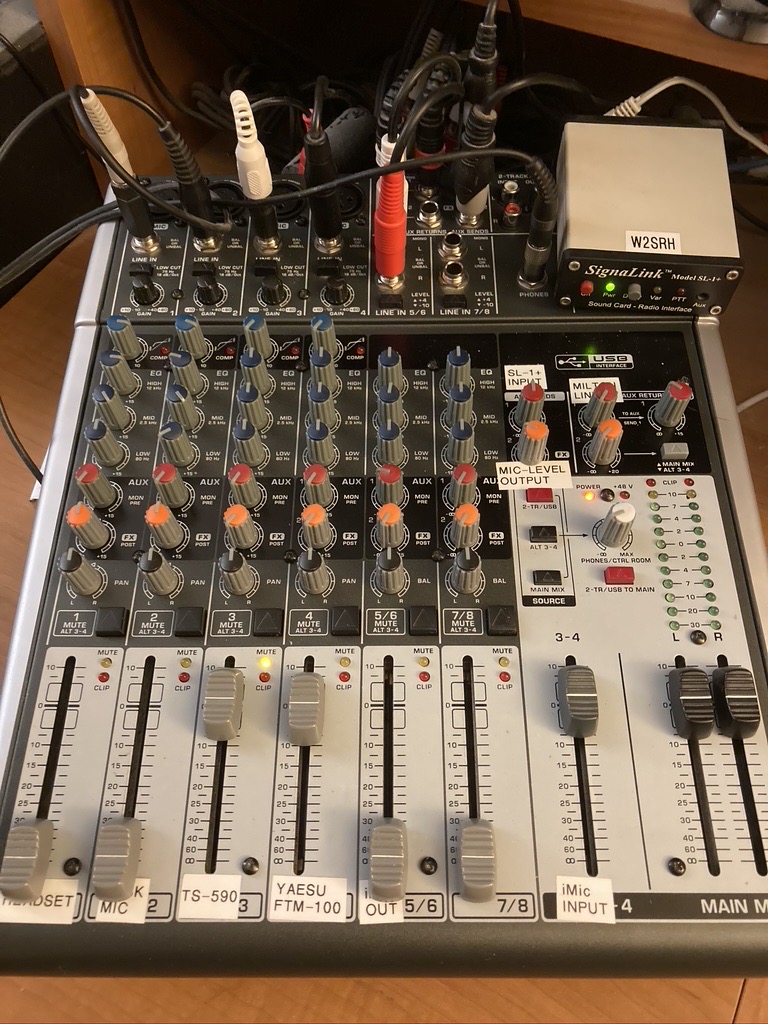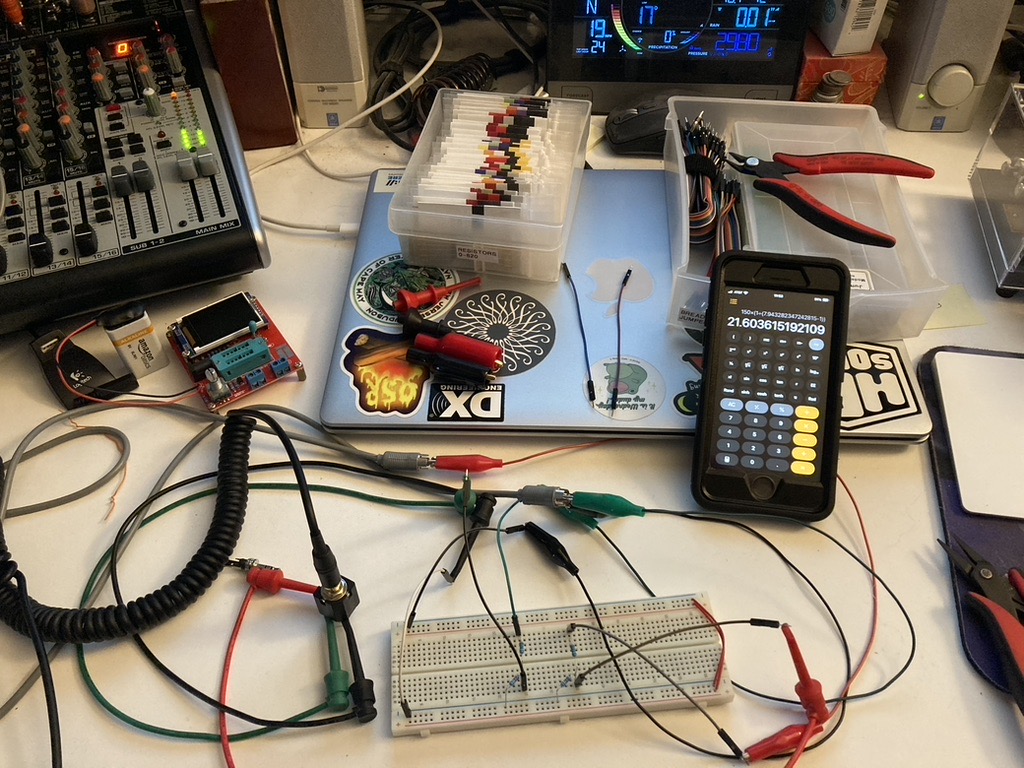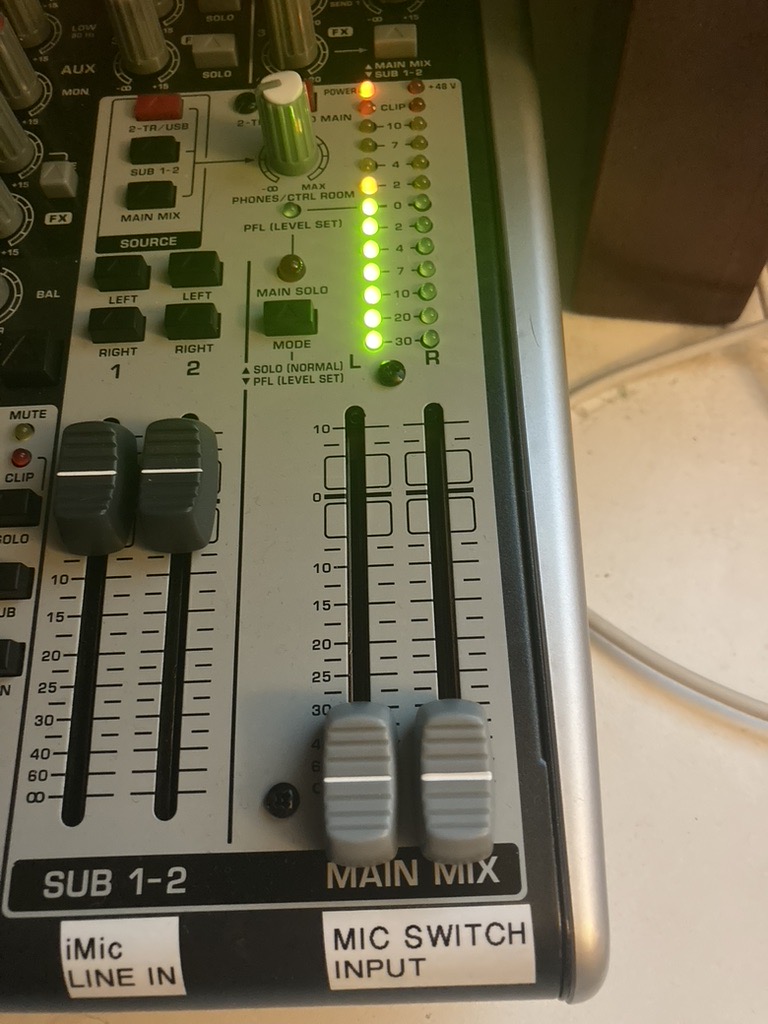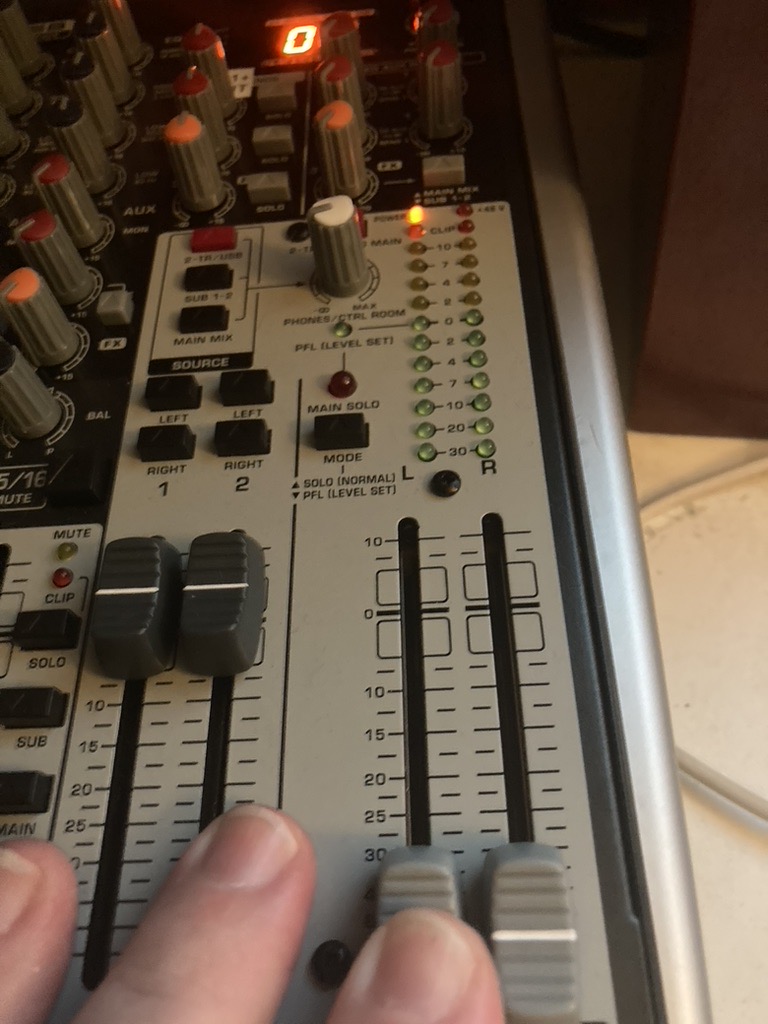You’ve got to trust your instinct
–311, “All Mixed Up”
And let go of regret

I seem to have had a run of bad luck with mixers lately. Why do I even have one? Well, I play with audio a lot, either because of various Zoom meetings, or because I do amateur radio stuff, or because I listen to music, whatever. And while the “simplest” solution for some of these is just to plug stuff right into the computer and have it work, I like flexibility. So my audio routing is… complicated. And I like it that way. Interestingly I’ve tried to write up how all that is done a couple times, and got as far as a few Reddit comments where I described it and a draft on here, but never officially published it. I don’t think this’ll cover the uses I wanted to with that post, though it will probably serve as a jump point, because the main issue here is that I’m annoyed with having to send back three mixing boards in less than a month.
Let me start with what all I have connected, and a little bit of why. For microphones I have a Heil PR-40 with a floating boom, and an old RadioShack mic on a desk stand. The latter was the first mic I ever had for DJ work back when I did parties and such, and when I started doing this kind of thing for the radio I used it as well as a Heil headset with an integrated microphone, but that headset developed a bad connection that would require disassembling the whole thing to repair and I’ve put them in storage for now instead. The PR-40 is the workhorse of most of my audio work, for good reason – it’s a damned fine piece of equipment and can handle whatever I throw at it. Plus it looks good in Zoom meetings 😀
Next on the inputs are the Kenwood TS-590s radio (connected via a RadioShack “ground loop isolator”, which is just an audio transformer that prevents ground hum from two systems being connected together) and the Yaesu FTM-100, also through an audio transformer for ground loop isolation but included in a homemade device I’ve described elsewhere. The last real input is a device from Griffin called an iMic, which is a simple USB audio input/output device that I use for specific reasons I’ll mention below.
In terms of outputs, there’s only a few. The iMic has the “Alt 3-4” output from the mixer as its input so I can send audio to the computer that way, and the main mix output is fed to the computer through the main USB connection on the mixer (which also serves as an input on the mixer, just not at the same time). For the “control room” output, I feed a Yamaha powered stereo speaker and subwoofer combination, as well as a headphone output feeding Sony MDR-7506 headphones. I do use the Aux Send 1 (pre-fader) output to a SignaLink SL-1+ interface box for digital radio modes, which is also an audio transformer as well as control line that can trigger my radio to transmit when there’s an audio signal present. I use the Aux Send 2 (post-fader) output to feed a homemade interface box that simply contains a 600? transformer and a few resistors arranged as a 40dB T-pad to take line-level audio and make it suitable to feed into the microphone input of the radios (this goes into the switch box linked in the article above). Finally, I do have the headphone output of the computer fed into an input on the mixer, and even hooked up the audio output from the monitor to an otherwise unused channel just in case I plugged something into it and needed audio from it (which was handy when testing my Raspberry Pi emulation system).
Before I move out of the exposition portion of this story, you may wonder why I have all those things setup and how they work together. I’d say it’s simple, but I think we’re past that point – I will say it’s elegant though, and I hope you might agree. For the most part, the Mac uses the mixer like a sound input/output device and doesn’t care what’s going on with it. When I play music, for example, it just streams over the USB cable and shows up on the “USB/2-TR” line which I can either feed directly into the room, or patch into the main mix if I wanted it to go out somewhere else. If I’m using a digital mode on my radio, which entails running a program on the computer to interpret the audio from the radio and possibly reply with audio as well, then I tell that program to use the iMic as its input/output device. I then can patch the appropriate radio into the “ALT 3-4” bus on the mixer, and audio from the radio gets sent to the iMic input. When the computer replies, it does so on the iMic, which I can sample from the pre-fader “Aux 1” bus and send to the SignaLink to make the radio transmit. Finally, if I want to speak into any of the radios, I can just use the appropriate microphone and when I use my footswitch to trigger it to transmit, the radio will be getting audio from the mixer sent to its microphone port.
As you can see, I have a lot of flexibility with all of the settings overall and have been quite happy with it. At least, until recently, when I noticed that a lot of noise was showing up. See, the Behringer 1204USB that I’ve been using was bought new in January 2013, and to put it lightly I’m not the best housekeeper. There’s been dust. Lots of dust. I don’t clean it off the surface nearly as much as I should, but really even if I did it’s dust inside that becomes the problem and that would be there no matter how much I wipe down the outside. So in November of 2024 or so I had enough of some of the noise and knew I had to do something about it. Some of the faders and pots were “crunchy” (making static when you move them, or when audio goes through them in a spot that isn’t the same as where it’s been for a long time). I have a can of contact cleaner here I might be able to use to clean things out, but since I use this for doing work meetings and such too, I didn’t want to start cleaning it only to find out it’s completely dead now due to doing something wrong. So I had added a new mixer to my wish list, commented that I might need to do that soon, and figured at some point I’d either break down and try cleaning it or buy a new one and then clean this one once it was no longer in the critical path. Well, Christmas morning as I was unwrapping presents, I was surprised to find one of them was the exact Behringer X1622USB that I had on my wish list. This was excellent news, I could replace the 1204 and have better quality audio, as well as clean the old one and pack it away as a backup or spare or whatever.
But when I started setting things up, The Trouble Started. Of course I had to make plans for how to move things around because there were a few differences (I might get into them some other time, this is already going long) but that wasn’t a big deal. What was a big deal, for me anyway, is that when I would turn the “Phones/Ctrl Room” volume knob around 25% or so, there was a spot where the audio definitely jumped. I tried to show it to others but they couldn’t quite hear it, though eventually I set up a test that made it quantifiable – feeding a 440Hz tone from the computer and using a decibel meter on my phone, the left channel would ramp normally up to 63dB, then jump to 76dB and continue rising from there. The right channel, however, would ramp normally to 66dB, then jump to 73dB. And the worst part is that this spot is right where I normally kept my headphones due to what sounded “loud” when I use them – the amplifier on the powered speakers was adjusted to roughly match the loudness so that there would be parity between wearing and not wearing the headphones. So, with a heavy heart we filed for an exchange for the mixer. They sent a new one, and I unboxed it, gave it a look over for obvious trouble, hooked up the basics.. and found it did the same thing exactly. The two units had serial numbers maybe 24 digits apart, so I wondered if maybe it was a bad batch? Either way, we filed an outright return, because my wife had a good idea: let’s go with another vendor entirely, so we rule out the bad batch problem. Perusing B&H I found the X1622USB was on backorder, unfortunately… but the X2222USB wasn’t, and there were a few other benefits that would be nice to have there. When I told her the price difference she said go ahead and just order it, and so I did. Unfortunately I found the exact same problem again!
This got me thinking that something else might be amiss here. And one thing that always bugged me is that the range of “usable volume” on that knob was extremely limited – as I said, around 25% of the way up is all I used to keep it, and that was considered loud in my ears. Why is that? Well, I did some more digging and think I came up with the answer. The headphones have a published impedance value of around 63?, while the mixer is rated on that output for 150?. Could it be that simple, an impedance mismatch is overdriving the headphones? Well the simple way to solve that is a plain resistive attenuator, so I went looking for the formulas and pulled out some components. After spending some time experimenting and gingerly testing the results, I hit on numbers that seemed to work well: 150? in-line with a 22? shunt to ground (L-pad) which ends up around an 18dB attenuation. Now I found that “comfortably loud” was around 1/2 scale on the volume knob, meaning I could still go a bit more for “uncomfortably loud” as well as have a lot of dynamic range on the adjustment now. And best of all, that “bad spot” around 25% was now down in the “is this thing even on” range and not at all a problem for me anymore.

I won’t get into the part of the story where a few days later I had tried to solder everything together, and even tested it before heading up the iron, but somehow still managed to swap one of the 150? and 22? pairs around making the device useless, and since it was heat shrunk and “finished” I tossed the whole thing in the trash. Well, okay, I guess I got into it. New one is sitting on the desk for me to try again in the next couple days. What I will get into though was the heartbreaking moment I had yesterday while in a meeting when I saw that my microphone audio was driving the left channel a little higher than the right. That shouldn’t be, it’s a mono input that’s centered, they should be equal. Well after some testing, I eventually found the issue – the left main mix fader must have a short in it. Feeding audio into the main bus and pulling down both faders, everything should be dead quiet. Instead the left channel was bouncing happily along at 0dB like nothing happened… unless I put a little pressure on the top of the fader knob, or to the side a little bit. Then it would finally cut down to -? like it should.


So with a heavy heart I filled out the RMA1 paperwork, was happy to get a response almost immediately from B&H with the return label, and now I’m stalking FedEx’s site to see when they get it and hope they quickly send a replacement.
- When I went to type this, I somehow mistyped RMA as FML. Honestly, I almost left it… ↩︎